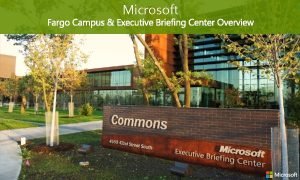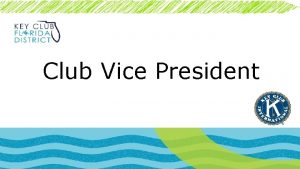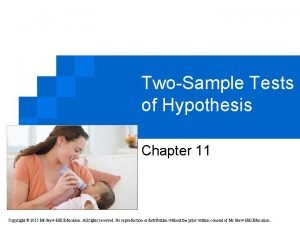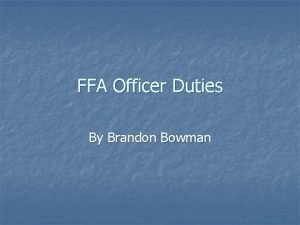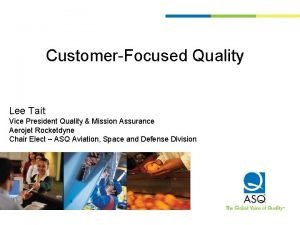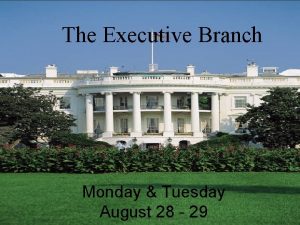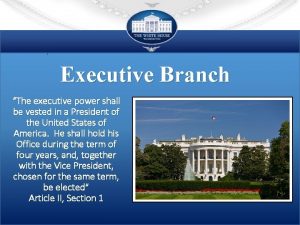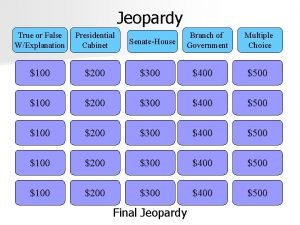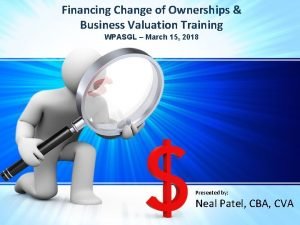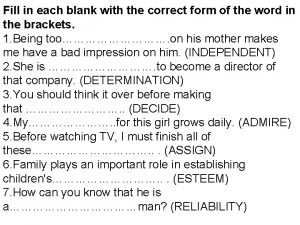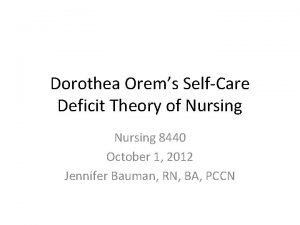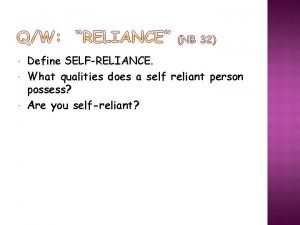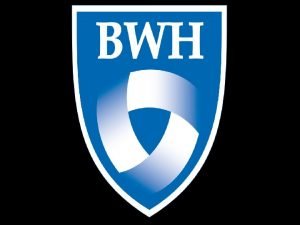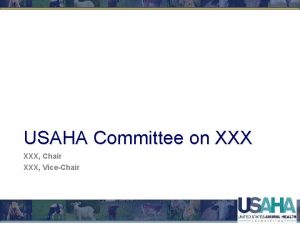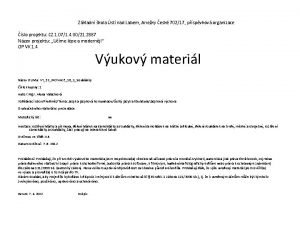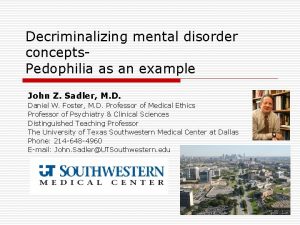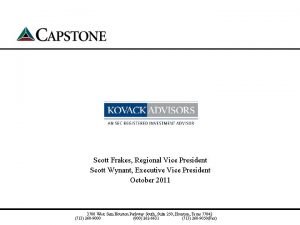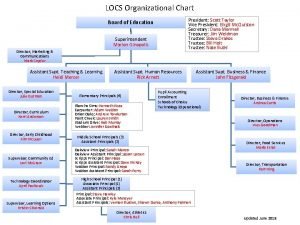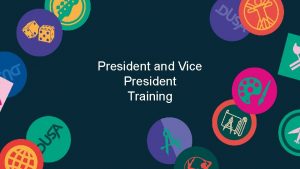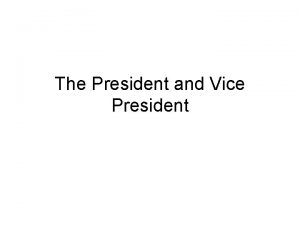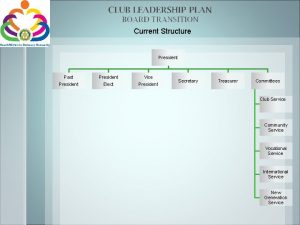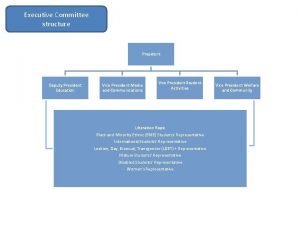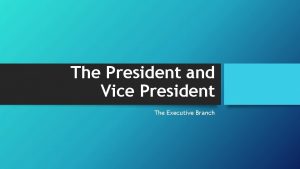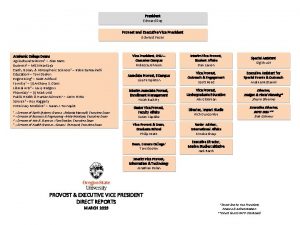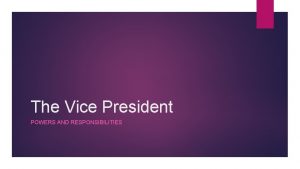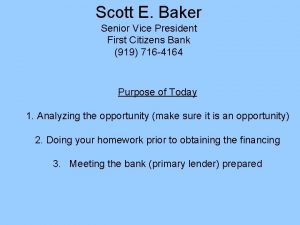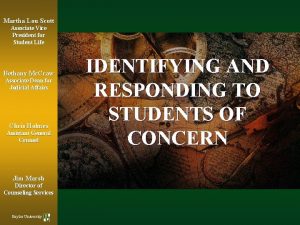Reliant Capital Solutions Scott Medley Executive Vice President





















































- Slides: 53

Reliant Capital Solutions Scott Medley Executive Vice President Sales For more than 35 years, COHEAO has served as the industry’s premier partnership of colleges, universities and organizations dedicated to promoting the Federal campus-based loan programs and addressing the most pressing issues in student financial services today. Driven by the demand for information and collaboration on the Perkins Loan Program, Student Financial Wellness and Student Financial Services, COHEAO provides opportunities for networking and professional development through its conferences, webinars and task forces, focusing on compliance, legislative and regulatory issues.

COHEAO Washington and Perkins Update Fall Ohio Bursar Conference 2018

Agenda Washington Update Administrative Cost Allowance Wind-Down Guidance Key Factors to Assessing your Portfolio Summary and Recap Resources Questions 3

Washington Update

“Breaking News” “I’m a Virgin” “Dems are on a Witch hunt” “Corruption in Congress” “Dems leaked Ford’s letter” “Guilty until proven innocent” 5

“More Breaking News” 6

“More Breaking News” 7

HEA Action in Congress The reauthorization of the Higher Education Act (HEA) was initially scheduled to be debated this year with the House majority introducing their comprehensive PROSPER Act (HR 4508) and the House minority introducing the Aim Higher Act (HR 6543). However, neither of these gained much traction as the reauthorization of the Perkins Career and Technical Education Act took precedence. Both of the bills introduced represent the higher education priorities for the Republicans and Democrats. The House Aim Higher Act does include the revival of the Perkins Loan Program, but it is closely based on the Obama Administration’s original 2009 proposal which would have created a Federal Direct unsubsidized program with terms and conditions like unsubsidized Stafford loans and servicing handled by the Direct Loan servicers. Campus loan allocations would be based on need as well as several other factors, including success in graduating Pell Grant recipients. This version includes provisions for deduction of administrative costs from the federal capital of the old Perkins program that is returned each quarter. It also allows a school to assign all loans to the Secretary who would then be required to return the institutional share to the institution as it is collected over time (with no administrative costs included). In either case, the institutional share of loan cancellation reimbursements would be included. HEA will likely be top on the agenda regardless of who controls the Senate and House after the November elections. 8

Department of Education – 2019 Budget The Budget maintains funding for essential K-12 formula grant programs that support the Nation’s neediest students, while also delivering on the President’s commitment to ensure that every child has the opportunity to attend a high-quality school that meets their unique educational needs The Budget proposes to ensure students can successfully pursue various pathways of postsecondary education and training. The Budget invests in career and technical education, streamlines student loan repayment, and offers the opportunity to use Pell Grants for high-quality, short-term training The Budget requests $59. 9 billion for the Department of Education, a $7. 1 billion or 10. 5% decrease from the 2017 enacted level 9

Higher Education Budget Initiatives Requires Colleges and Universities to Have Shared Accountability for Repayment of Federal Student Loans Reforms Student Loan Programs Expands Pell Grant Eligibility for Short-Term Programs Improves Grant Making and Maintains Support for Minority-Serving Institutions (MSIs) and Historically Black Colleges and Universities (HBCUs) Invests in Evidence-Based Postsecondary Preparation Programs Supports a Reauthorized Higher Education Act (HEA) Workforce Supports Career and Technical Education (CTE) Revamps Federal Work Study to Emphasize Workforce Development. Promotes Science, Technology, Engineering and Mathematics (STEM) Education Modernizes and Makes Government More Efficient Reduces Waste: Streamlines or Eliminates Ineffective or Redundant Programs 10

HEA Action in Congress HEA reauthorization process activated in 2017 – House Education & Workforce Committee approved “PROSPER Act” in December Chairwoman Foxx working to get votes to pass House – Needs almost all Republicans since bill has no Democratic support – not there yet House Democrats introduced “Aim Higher Act” in July; amalgam of bills introduced before – no action 11

Harm to Students Survey Results Approximately 95, 000 Perkins Loan awards were cancelled on 10/01/17 for students who had accepted the award but had not yet completed the required paperwork by the 09/30/17 deadline. Currently, an estimated 120, 000 students have outstanding balances/financial holds on their accounts. Perkins Loans would help to resolve those balances. For those students that accepted the award but did NOT receive their Perkins Loan: • 64% had a balance that needed to be funded some other way • 31% were supplemented with other aid • 5% were forced to leave School immediately 12

Congress – Friend or Foe? 13

HEA in House – PROSPER Act House bill: “PROSPER Act” Replaces Direct Loan Program with new Federal One Loan Program No Perkins or SEOG, major changes to Direct Loan Program – No Grad PLUS, Parent PLUS capped, – Subsidized Direct loans eliminated for undergrads – Unsubsidized Direct limits increased to make up for loss of Perkins Streamlines Repayment Plans – Standard 10 -year, with longer periods permitted for consolidation loans – Income Derived: payments = 15% of discretionary income, but all principal and 10 -years-worth of interest have to be repaid before forgiveness allowed Increases Pell Grants -- $300 bonus if taking 15 credit hours Eliminates Public Service Loan Forgiveness 14

PROSPER Act Forces Ed to provide initial finding of program reviews within 90 days Expands FWS with revised funding formula and eliminates graduate eligibility Repeals Teach Grants, some other grant programs Pay checks for Students – Credit balance refunds would be paid to student in equal monthly or weekly installments – Deposited on a debit card – First installment may be paid as early as 30 days before first day of classes, no later than 30 days after they start. 15

PROSPER Act Risk Sharing and Accountability – Replace cohort default rate with loan repayment rate (calculated by program of study) • Programs where fewer than 45 percent of former students are making required payments could lose Title IV eligibility. • 90 -10 Rule repealed. • Gainful employment requirement repealed. – Tighten rules on “earned aid” under R 2 T 4 for withdrawn students, so schools bear more cost. – Require schools to repay ED for some portion of defaulted loans. 16

Aim Higher Act Introduced July 26 by Education & Workforce Ranking Democrat Bobby Scott (VA) 811 -page bill generally keeps status quo on aid, unlike PROSPER, with some changes – Pell Grants maximum raised, indexed to inflation, opened to shorter programs – Perkins Loan Program recreated along “unsubsidized Perkins” model proposed in Obama Administration with terms like unsubsidized Direct loans, federal loan servicing, nationwide volume limit. Open to modifying it. – Caps on Direct, PLUS loans unchanged – States required to make two years of college free – PSLF (Public Service Loan Forgiveness) expanded 17

Aim Higher Act Changes CDR calculations, makes 90 -10 rule 85 -15 and counts GI Bill funds same as Title IV. Eliminates origination fees Retains and expands Teach Grants, FWS Simplifies repayment plans like PROSPER, but keeps forgiveness after 20 years. Meant to be an alternative to PROSPER so some holes in it. Won’t get hearing in House this year, but will be base of HEA proposal in 2019 if House majority changes 18

Perkins 2. 0 – 21 st Century Perkins COHEAO proposal for HEA Reauthorization includes a new Perkins Loan Program: One for One Replacement – New federal funds replace the existing revolving loan funds School match – level to be determined Updates the allocation formula, phases out the base guarantee No in-school interest No origination fees and loans remain low interest Maintains cancellations for public service Servicing remains school based subject to current regulations 19

Update on Perkins Loans 2018 Despite much support, Perkins remains expired – H. R. 2482 – Introduced on 5/17/17 – two year extension through 9/30/19. – 253 cosponsors, a majority of the 435 members of the House of Representatives – 51 Rs and 192 Ds. S. 1808 – Introduced 9/14/17 – same as House bill. 22 cosponsors -- 4 Rs and 18 Ds. Not sponsoring: House Education and the Workforce Committee Chairwoman Virginia Foxx (R-NC) Senate HELP Committee Chairman Lamar Alexander (R-TN) This is most unfortunate! 20

Perkins Status Just because the program has expired doesn’t mean it can’t be resurrected. COHEAO will work to ensure institutions receive the money they are due. – ED should permit campuses to retain their share of unreimbursed cancelled loans. Also, there is a need for ACA to be paid to support school servicing! A lot of campus money remains on the table. 21

DOE Appropriations Bill Administrative Cost Allowance (ACA) won’t be paid for Perkins because it’s based on new origination volume. COHEAO called for change in law so part of returned federal share goes to schools who choose to service. Gives the Dept. of Ed authority to fund Perkins servicing from SL servicing Calls for return of institutional share of cancelled loans 22

DOE Appropriations Bill Passed in the Senate by wide margin The specific language included reads as follows: “Funds appropriated in this Act…may be available for payments for student loan servicing to an institution of higher education that services outstanding Federal Perkins Loans. ” Dept of Ed has the authority to pay the institutions for servicing the loans. This language provides the Department the authority to ensure current loan holders’ portfolios continuity of servicing with universities. The House will be voting on this same package where the bill is expected to pass and subsequently be signed into law. 23

Administrative Cost Allowance

Administrative Cost Allowance A school participating in the campus-based programs is entitled to an Administrative Cost Allowance (ACA) if it advances funds under the Perkins Loan, FSEOG, and/or FWS Programs. ACA calculation = 5% of Expenditures (up to $2, 750, 000 and then on a declining percentage). Schools are allowed to charge the ACA to one or all of the programs as best meets their needs. No Perkins ACA may be charged after 2017 -18 fiscal year. 25

Administrative Cost Allowance COHEAO believes that ACA is the key to sustaining quality campus-based servicing of the Perkins portfolio and schools should be compensated. – The school has the incentive and ability to collect more $ and can likely do it for less than the Perkins servicer. – The school has a vested interest in how the loans are serviced because of the alumni relationship. – ACA allows the school the ability to maximize the recovery of its investment (Institutional Capital Contribution). – Supports and protects jobs on campus. 26

Administrative Cost Allowance Why ACA is the key to sustaining quality campusbased servicing of the Perkins loans: – Schools who want to service their loans won’t be forced to liquidate due to cost of administering the program. – Mass assignments may result in delays, errors and confusion to the borrowers. – Delays in servicing could result in borrower delinquency, credit profile issues, and/or loss of benefits. – It’s a win-win for the schools who want to continue servicing the loans and the Department to pay the schools less to do so. 27

Administrative Cost Allowance What you can do to help advocate for the ACA Proposal: – Educate your government relations and upper administration personnel – Reach out to your Congressional Members in the House and Senate – Share the information with colleagues – When the time is right, help advocate with the Dept of Education – Visit COHEAO. com for current information and resources 28

Last Friday, September 28 th, President Trump signed into law H. R. 6157, the spending package to fund the Department of Defense, and most non-military, labor, health and human services, and education programs for the 219 fiscal year beginning October 1. The bill includes the provision allowing payments to schools for Perkins Loan servicing that was included in the House and Senate versions of the legislation. COHEAO worked extensively since the spring on securing passage of this provision. SEC. 308. Funds appropriated in this Act under the heading ‘‘Student Aid Administration’’ may be available for payments for student loan servicing to an institution of higher education that services outstanding Federal Perkins Loans under part E of title IV of the Higher Education Act of 1965 (20 U. S. C. 1087 aa et seq. ). 29

ICC and Institutional Loans Institutional share of returned Perkins funds can be used for any purpose One logical proposal is to at least partially replace Perkins with an institutional loan program using recaptured institutional share Can also attract funds from donors or make arrangements with third-party lenders COHEAO has new Institutional Loan Task Force to explore solutions and best practices – More information forthcoming from COHEAO 30

Perkins Wind-Down Guidance

Department Guidance on Perkins DCL GEN-17 -10 (Perkins Wind-Down Instructions) Institutions are not required to assign their Perkins loans or liquidate their Perkins portfolio. Institutions may continue servicing their Perkins Loans until all outstanding loans have been: – Paid in full – Otherwise fully retired (cancelled, written off, etc. ) – Assigned to the Department Institutions may choose to liquidate at any time in the future and may assign defaulted and/or non-defaulted Perkins loans to the Department at any time. 32

Department Guidance on Perkins The institution loses all rights to assigned loans and will not receive any share of future funds collected. Borrower’s retain all of their benefits when their loan is assigned to the Department. Institutions that continue servicing their Perkins Loan portfolios must continue to: – Service the loans in accordance with the regulations – Report their outstanding loan portfolio using the FISAP An administrative cost allowance cannot be charged against an institution’s Perkins fund after June 30, 2018 because institutions will no longer be advancing funds. 33

Department Guidance on Perkins IFAP Electronic Announcement July 11, 2018 - Perkins Loan Revolving Fund Distribution of Assets and Timelines for 2018 -19 – The Distribution of Assets process replaces the existing excess cash process. – The Department will require a capital distribution from the institution’s Perkins Fund on an annual basis. – After the 2017 -18 FISAP is submitted through COD by October 1, 2018, the Department will send a notification to institutions that have cash in the Perkins Fund are subject to the distribution of assets process. 34

Department Guidance on Perkins Distribution of Assets and Timelines for 2018 -19 – Institutions will be notified of the amount of federal share and institutional share that must be returned and the deadline by which these funds must be returned. – For this year, due to system updates, the notification to schools will be delayed until December, which would likely lead to a January deadline for the return of funds. – Institutions must return the federal share to the Department through the COD system and remove the institutional share from the fund. 35

Department Guidance on Perkins Distribution of Assets and Timelines for 2018 -19 – Using the FISAP, the Proportional Share Worksheet calculates the percentage of cash in the fund that must be returned to the Department and the percentage that must be returned to the Institution. – If returning the federal and institutional share creates a shortfall in the funds available for meeting the school’s permissible collection costs through June 30, 2019, the institution may request an adjustment through COD. – Institutions are only permitted to charge the Fund for the costs of litigation incurred in collection of the principal and interest on loans not already reimbursed from the Perkins Fund or from payments by the borrower. 34 CFR 674. 47(e) 36

Key Factors to Assessment

6 Factors for Assessment 1. What is the value of your Institution’s Investment 2. What are the benefits of servicing 3. How to project future revenue 4. Maximizing your recoveries 5. Identifying the cost of servicing 6. What are the costs and risks of liquidation 38

Key Factors to Assessment • 39

Key Factors to Assessment 2) Why Continue to Service your Portfolio? – Recover your institution’s investment (ICC). – Utilize the ICC to fund an institutional loan program or provide additional aid to students. – Foster the borrower/alumni relationship. – Convert as many loans to paid-in-full as possible (fewer loans to assign in the future = less work and less liability). – Clean up and/or reconcile your Perkins portfolio first – Rejected loans in liquidation result in a cost to the campus – must buy the loan if you can’t resolve. • Rejected loans in an assignment usually do not – you can continue to service the loan. 40

Key Factors to Assessment 3) Projecting your Portfolio’s Revenue Potential – Analyze monthly collections and create a recovery forecast • Utilize historical collections and paid-in-full data, take into account the % of borrowers enrolled or in grace. – Apply your ICC Proportional Share Percentage to your estimated monthly collections to determine ICC Revenue – What costs can be charged to the fund • Billing Costs: unpaid portion of the actual cost of phone calls made to demand payment on past-due accounts • Collection Costs: waived collection agency fees, successful address searches, credit bureau reporting costs, and costs of responding to inquiries – What is the potential ACA if based on collections? – Do you have short-term loans to the fund to recover? 41

Key Factors to Assessment 4) Maximize your Portfolio’s Recoveries and ICC – Review your portfolio and ensure that all delinquent accounts are placed with your TOP Performing collection agencies – Leverage the advanced technologies of your TOPPerforming collection agencies • • • Data scrubs for bankruptcy, death and disability Skip-tracing technologies to locate borrowers Credit reporting to all three major credit bureaus Updated employment and demographic data Data analytics used to predict probability to pay based on dozens of attributes • Credit monitoring – notified when credit activity occurs 42

Key Factors to Assessment 5) Identify the Cost to Service your Perkins Loans – Fixed vs. variable costs • Fixed: salaries, maintenance fees, reporting fees to credit bureau, NSLDS, etc. • Variable: per-borrower billing costs, postage, phone calls, skip-tracing, Clearinghouse – Where can costs be reduced • Natural decline in billing costs, e-signature, postage • Utilize your recovery forecast and paid-in-full averages to estimate account volume • Salaries: staff attrition, cross training for other areas 43

Key Factors to Assessment 6) Identify the Costs and Risks of Liquidating – Having to buy rejected loans – Forfeiting your institution’s investment (ICC) – Additional resources required to oversee and complete the liquidation process – Recent conversion to a new servicer and potential discrepancies, missing documentation, etc. – Job loss – Loss of control in how the loan is serviced (i. e. alumni relationship) 44

Summary & Recap

In Summary… Evaluate your Perkins Portfolio – What are the costs and benefits of servicing – What are the risks and benefits of liquidation – What is the long-term projection for return on investment Communicate with decision-makers on campus – Discuss costs, benefits, risks and resources Maximize Returns – ICC Recovery – Recirculate accounts to your collection agencies – Maximize the ability to reinvest into an Institutional Loan Program or 21 st Century Perkins Loan Program – Support the operational costs of servicing the program – Pay yourself back for any overmatch (i. e short-term loans to the fund). 46

In Summary… Minimize Risk: Clean up your Portfolio before Liquidation – – Assign older uncollectible loans first Review your due diligence procedures and documentation Review and document your electronic signature process Reconcile NSLDS Communicate your Post-Perkins resource challenges to your Congressional Representatives and/or COHEAO – enrollment, retention, financing Utilize COHEAO as a resource for your compliance and training needs – http: //www. coheao. org 47

COHEAO

Become a Member of COHEAO Membership Benefits: – 3 FREE Webinars per year – Regulatory & Legislative Updates – Torch & Sparks – Lead organization on Perkins advocacy – A LOT More than just Perkins: • Advocacy and training on legal and compliance issues that • • • impact you and your institution directly TCPA & CFPB Compliance Student Tuition and Accounts Receivable (STAR), Institutional Loan Task Force Financial Wellness – Newsletters, Training, Whitepapers A Voice on Capitol Hill – Advocacy and Relationships – Institutional membership rates are very affordable: $210 - $595 based on FTE (10% discount when you join within 30 days of this presentation). 49

Resources

Resource Links IFAP Announcement – Federal Perkins Loan Revolving Fund Distribution of Assets and Timelines for 2018 -19 https: //ifap. ed. gov/eannouncements/071118 CBPerkins. Loan. Revol Fund. Distribution. Of. Assets 1819. html Dear Colleague Letter: GEN-17 -10 Perkins Loan Extension Act of 2015: https: //ifap. ed. gov/dpcletters/GEN 1710. html Federal Perkins Loan - Assignment and Liquidation Guide https: //ifap. ed. gov/cbpmaterials/attachments/Perkins. Assignmenta nd. Liquidation. Guide. pdf Perkins Loan Assignment System (PLAS) https: //ifap. ed. gov/eannouncements/attachments/092115 Perkins. L oan. Assignment. System. Availand. User. Access. Info. Attach. pdf Federal Perkins Loan FAQs - https: //ifap. ed. gov/cbp/Perkins. FAQ. html PROSPER Act - https: //edworkforce. house. gov/prosper/ 51

Contact Information Harrison Wadsworth COHEAO Executive Director Principal, Bose Washington Partners 202 -349 -2303 hwadsworth@bosewashingtonpartners. com Maria Livolsi COHEAO President Director, State University of New York Student Loan Service Center 518 -525 -2628 mlivolsi@albany. edu 52

Questions… 53
 Ducks unlimited checks
Ducks unlimited checks Microsoft executive vice president
Microsoft executive vice president Reliant capital solutions department of education
Reliant capital solutions department of education Vice president duties in a club
Vice president duties in a club Mary jo fitzpatrick is the vice president
Mary jo fitzpatrick is the vice president Mark welb
Mark welb Vice president training
Vice president training Senior regional vice president
Senior regional vice president Vpm membership
Vpm membership Ffa symbols for officers
Ffa symbols for officers Senior regional vice president
Senior regional vice president Senior regional vice president
Senior regional vice president Senior regional vice president
Senior regional vice president Ffa officers duties
Ffa officers duties Lee tait
Lee tait Vice president training
Vice president training God is an awesome god and greatly to be praised
God is an awesome god and greatly to be praised Relais medley
Relais medley Executive office of the president
Executive office of the president Executive office of the president
Executive office of the president The executive power shall be vested in a president
The executive power shall be vested in a president There are 10 cabinet positions true or false
There are 10 cabinet positions true or false Reliant business valuation
Reliant business valuation Fill in each
Fill in each Self-reliant
Self-reliant Characteristic of self-reliance
Characteristic of self-reliance Ecocentric anthropocentric technocentric
Ecocentric anthropocentric technocentric Inr ranges
Inr ranges Reliant emc
Reliant emc Pretoria executive capital
Pretoria executive capital Fixed capital and working capital
Fixed capital and working capital Difference between capital reserve and reserve capital
Difference between capital reserve and reserve capital Multinational cost of capital and capital structure
Multinational cost of capital and capital structure Difference between capital reserve and reserve capital
Difference between capital reserve and reserve capital Basle ii
Basle ii Regulatory capital vs economic capital
Regulatory capital vs economic capital Constant vs variable capital
Constant vs variable capital Multinational cost of capital and capital structure
Multinational cost of capital and capital structure Capital allocation line vs capital market line
Capital allocation line vs capital market line Kalkulace neúplných nákladů
Kalkulace neúplných nákladů Inherent vice definition
Inherent vice definition How to become a gangster disciple
How to become a gangster disciple Extremism in the defense of liberty is no vice
Extremism in the defense of liberty is no vice Changing decimals to fractions and vice versa
Changing decimals to fractions and vice versa Vice reinos espanhois
Vice reinos espanhois Xxx
Xxx Inherent vice of capitalism
Inherent vice of capitalism What do vice presidents do in clubs
What do vice presidents do in clubs Tungkulin at kapangyarihan ng residencia
Tungkulin at kapangyarihan ng residencia Conversion of work into heat and vice versa
Conversion of work into heat and vice versa Party is such sweet sorrow vice game
Party is such sweet sorrow vice game H ch k r d t n
H ch k r d t n Tanuvas vice chancellor
Tanuvas vice chancellor Vice-laden
Vice-laden

